
The record label Music Co. was experiencing a high number of incident tickets regarding its digital release planning system, mostly as a result of delays in a release, reported by the sales team. To help deliver their record products in a more timely fashion, the organization used the DMAIC roadmap to uncover the causes of the delays in their planning system and develop countermeasures.
Record Label 101
To begin, it may help to review the business of a recording company in a high-level manner. Some terms to understand:
- Recording companies manage different record labels within the company.
- Record labels are brands associated with the marketing of music recordings and videos. A label signs contracts with artists and maintains a wide-ranging repertoire of genres, such as pop, jazz, country, classical and Latin.
- Planning system is a tool used by a label company to plan and schedule a release. The system handles physical products, such as CDs, vinyl albums and cassette tapes. With the advent of digital music, these systems have been enhanced to handle physical, digital and mobile distributions. This means a user can still maintain physical releases and also schedule digital/mobile releases. Unlike physical products, digital recordings are released to digital service providers, such as Apple iTunes, eMusic, BuyMusic and Rhapsody, as soon as they are approved by release management. From the customer’s (distributors) perspective, the accuracy and timeliness of a release is critical to achieve customer satisfaction.
Starting the Project
With digital music, the entire recording industry acts in concert. If the product is not available at the scheduled time on a vendor website, consumers may opt for a pirated version. This is something the labels, vendors, artists and other value-added resellers do not want to happen. Therefore, the record label’s customers believe that timely delivery of products to the sales team without error is essential. This is considered a critical-to-quality (CTQ) characteristic of the process. From the business perspective, the record label in this project believed that efficiency and transparency between multiple elements of the system could improve cycle time.
To consider if this project was a candidate for the application of Six Sigma, the Music Co. organization was asked to complete a project qualification checklist (Table 1).
| Checklist | High | Medium | Low |
|---|---|---|---|
| How important is this project to your customer? | Y | ||
| Is there a Champion who feels that the project is important? | Y | ||
| Is there a Green Belt to assist this project? | Y | ||
| Is the CTQ characteristic measurable? | Y | ||
| Is data available or easily tracked? | Y | ||
| Are the benefits easily measurable? | Y | ||
| Is the process stabilized or under control? | Y | ||
| Is the scope narrow enough to finish in four to six months? | Y | ||
| Is this project considered important within the organization? | Y | ||
| Are there alternative solutions available? | Y | ||
| Total weight | 8 | 2 |
The project qualified, and a team was established to work on this project. The case study followed the DMAIC steps.
Define
In this phase, the team created a SIPOC diagram (Figure 1).
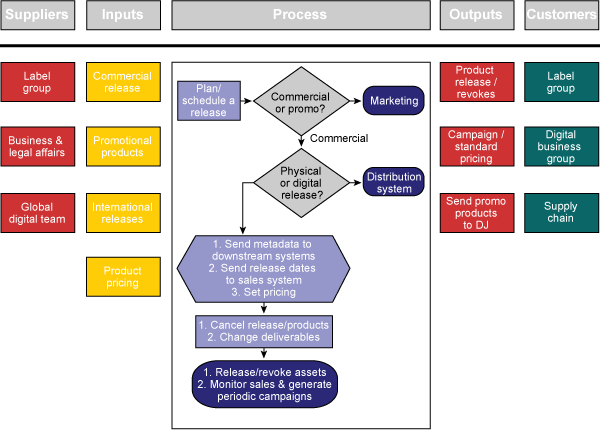
The effects of continuing the process as is are depicted in Figure 2, the loss-gain matrix. For example, a vendor may try to renegotiate the price if the product is not delivered on time, and pricing power switches to the vendors. Also, an artist may drop future contracts.
Figure 2: Loss-Gain Matrix
| Loss | Gain | |
| Short Term | -Impact on overall resolution -Related dissatisfaction |
-Improved resolution -Related satisfaction |
| Long Term | -Client escalations -Loss of business |
-Client satisfaction -More business -Revenue Growth |
Measure
Under the current process, 14 weeks is the optimal time for a product to move from a creation request to hitting the market. Figure 3 shows the timeline and the process steps for a cycle of release.
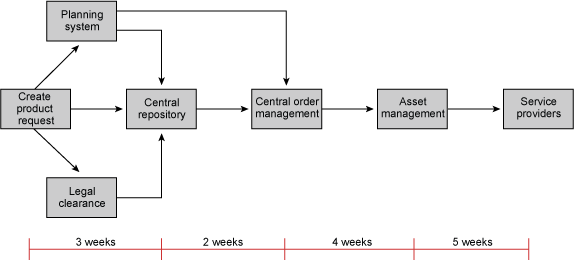
The project team collected data from issue tracking tools, emails and requests made on the fly over the phone. All source information was tracked in a spreadsheet for the period of October 2008 through July 2009. Figure 4 depicts a run chart of system interruptions and resolution efforts over this period.
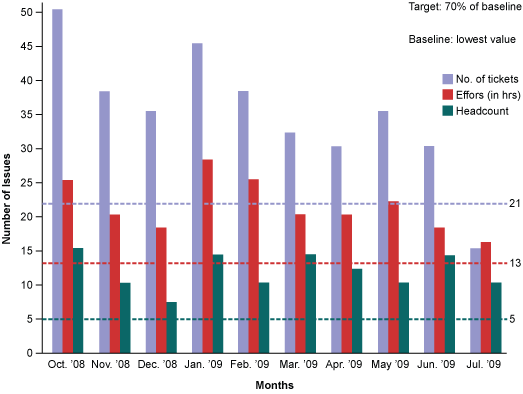
The chart shows how many tickets were opened in a month, the hours spent and the number of people involved to resolve the issue over a 10-month period. Because delays are caused by problems in the planning process, the team set a target of reducing the number of incident tickets to 21 per month. The baseline data shows a sigma level for the process of 1.78.
Analyze
In this phase, the team focused on process variation. A product release date is established upon the signing of an artist contract. Therefore, it is the responsibility of labels to make sure the product is delivered on time. Anything not delivered to the customer (i.e., service providers) before cut-off time causes a delay in the promotion of a product.
The expectation for this project was to reduce Priority 1 (P1) and Priority 2 (P2) tickets to a great extent. P1 and P2 tickets consume significant time and cost, and involve system issues such as:
- Software bugs
- Inefficient handling of products due to lack of experience/training
- Process follow through
- Testing efforts (both IT and business)
The project team developed a cause-and-effect diagram for the delays in product release cycle time, seen here in Figure 5.
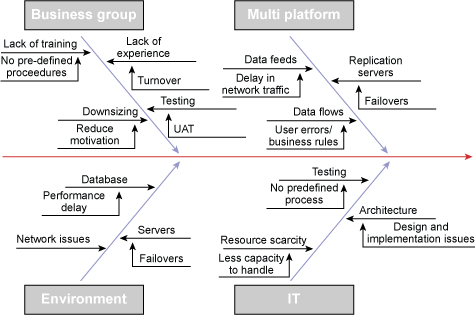
The team concentrated on four key areas and their underlying causes of delays:
1. Business group:
- Lack of training for label planners due to staff turnover; more ambiguity among new employees.
- Lack of experience due to staff turnover.
- Reduced motivation due to downsizing.
- Lack of user acceptance testing, which meant issues were not noticed until the production stage.
2. Multi-platform:
- Data feeds – Network error/congestion that caused delays in data movement, which was driven using feed files.
- Replication servers – When source servers failed, they triggered an unexpected failover.
- Data flows – Erroneous data from the source system created havoc in all downstream systems.
3. Planning-system centric environment
- Database – Performance within the database restricted product movement.
- Server issues – Failure in production servers that schedule jobs.
- Network issues – Network failures and traffic.
4. Information Systems and Technology:
- Architecture – Software design issues
- Testing – Lack of resource-reducing testing time
- Network issues – Network failures and traffic
After numerous brainstorming sessions, the team discovered that many of the defects were similar in nature. They grouped predominant or common issues under the same issue classification and tracked the number of errors in each category. The data was displayed in a Pareto diagram (Figure 6).
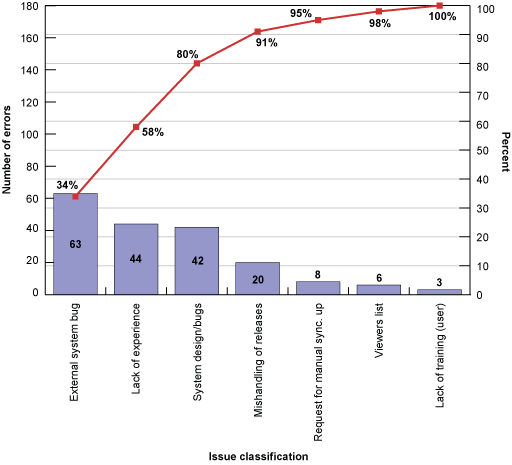
External system bugs, lack of experience among business groups and system design defects accounted for 80 percent of the causes of delay.
Improve
The team then developed countermeasures to prevent the main causes of these delays. The actions taken by the team are summarized in Table 2.
Table 2: Action Plan
| Action Item No. | Description | Owner | Due Date | Function | Root Causes |
|---|---|---|---|---|---|
| 1 | Meet with Quality Assurance to review current testing plan specific to the planning system | System engineer | Aug. 5, 2009 | Release management | Errors/bugs in design of planning system |
| 2 | Provide logs of external system bug errors to vendor for evaluation and recommendation | Vendor manager | Aug. 19, 2009 | OLA management | Bugs sourced from external systems |
| 3 | Test the software fix to the timing feature on the planning system | QA analyst | Aug. 28, 2009 | Quality Assurance | |
| 4 | Audit and report point-to-point network failures in digital release process | Network administrator | Aug. 28, 2009 | Network engineering | |
| 5 | Establish training procedures and best practice guidelines for new and existing employees | IT communication manager | Aug. 28, 2009 – review first draft | Service management | Lack of experience, training |
Figure 7 shows the improvement targets that the team set. After taking the countermeasures, the team estimated that the process would perform at a 3.04 sigma level.
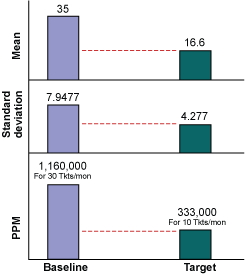
Control
The team implemented the action plan and tracked performance. Figure 8 shows the run chart of improvements that were achieved.
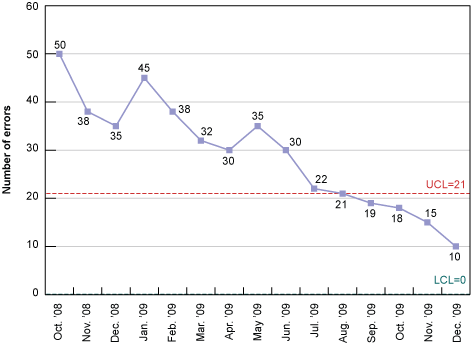
Lessons Learned
Understanding customer experience is key to driving business improvement. Applying quantitative tools and techniques – namely the Pareto chart, control chart and cause-and-effect diagram – can focus the analysis on the root causes of defects and inefficiencies.
Because this project involved a process that is so crucial for the recording business, the overall results are far reaching. Due the project, the record label:
- Has a projected growth in revenue of more than $2 million per year
- Has reduced downtime, which helps improve cycle time to hours rather than days
- Is able to handle new product development features rapidly